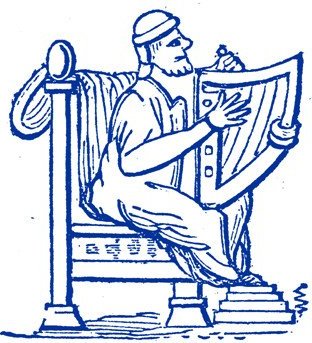
NORMAN HAY (1889 - 1943)
- a brief biography and a list of his works
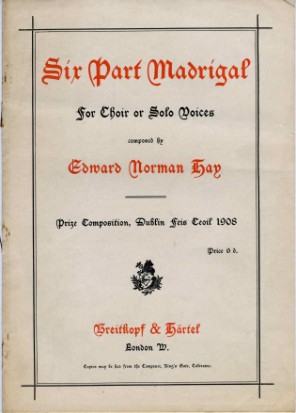
His music often spoke with a more contemporary voice than was usual in Ireland during the first decades of the 20th century.
In several cases it was deemed too modern for those who had to play it, let alone those who had to listen to it.
His personality was all that being an honest Ulsterman might imply!
The early years
Edward Norman Hay was born on 19 April 1889 in Faversham, Kent. His father, a Coleraine man, was a customs officer. When his mother died in January 1891, Mr Joseph Hay obtained a transfer back to the north of Ireland and his son Norman went to live with his aunts in Coleraine. At nine months Norman contracted polio which left him unable to walk until twelve years old and with a permanent limp.
"Accordingly, I induced an aunt, mildly musical, to write out those for me on the back of a used envelope. Fortunately, I was allowed, at that time, pretty much to ‘gang my ain gait’ about ordinary school subjects (hence my hearty sympathy with present-day musical youngsters who are faced with that monster of childhood, homework), so after three gruelling days I was able to play my first hymn-tune in four parts."
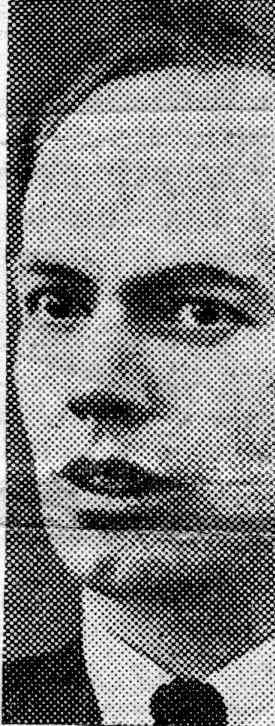
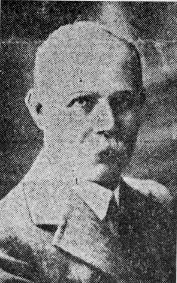
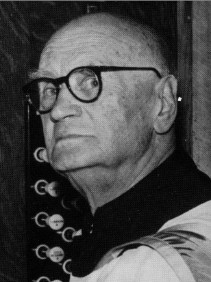
"In that period I had also organ lessons from Capt. Brennan, and learnt from him, amongst many other priceless things, how Bach can become a living reality when phrased with poetic meaning.”
Some other Koeller works include 'Tis Night, four-part song, words by T. D'Arcy McGee (R. Cocks & Co., 1897); Early Morn, cello and piano (Weekes & Co.,1905); For you and me (from Sir George's Folly - a two act comic opera, book by William Livingstone, performed at the Royal [Theatre Royal?], Belfast, on 27 January 1908), song with violin obbligato (Novello & Co., 1908); and Somebody, sacred song, words by J.R. Clements (Marshall Brothers, 1912).

|
Francis Koeller obituary.pdf Size : 224.291 Kb Type : pdf |
Walker was a distinguished pianist (the Musical Times, June, 1897, recorded that he was the soloist in John Field's Piano Concerto in A flat at the Feis Ceoil in Dublin that year), organist (St Nicholas, Carrickfergus and then St James' Church, Belfast) and the Lecturer in Music at Queen's College, Belfast (1902-1928). The College's Annual Report for 1908-1909 stated:
Footnote: Queen's College (becoming Queen's University in 1908) initially had just a part-time lectureship in music, established in 1902 when Lawrence Walker was appointed. He was succeeded by Capt. Brennan in 1928 and then Norman Hay in 1941. On Hay's death in 1943, Capt. Brennan was reappointed. The full-time music lectureship was established in 1947 with the appointment of Ivor Keys.
Excerpt from the President's Report, Queen's College Belfast, April 1903: "By the authority of the Lord Lieutenant, there had been founded ... a College Lectureship in Music — one step in the right direction — and he had the further pleasure that afternoon of announcing that they had appointed the first Lecturer — Dr. Lawrence Walker. Dr. Walker was a graduate in Arts of the University of Dublin, and a doctor of music of the University of Cambridge, and he thought no one in Belfast, where he had gained such a high reputation in musical circles, would doubt that in his hands the Lectureship was likely to be a real power for good. But he wondered if he was unduly sanguine in cherishing the hope that that Lectureship would ere long grow into something greater ... by founding a fully-equipped Professorship ..."
Charles John Brennan (1876-1972) was organist of St Anne's Cathedral in Belfast from 1904 to 1964 - could that be a world record for a cathedral organist? (Olivier Messiaen served longer at Paris's Église de la Sainte-Trinité, but that's not a cathedral!). Capt. Brennan was also Belfast City Organist (1907-1972). A biography is available online here.
First successes
Hay proceeded to the degree of D.Mus. by external examination from Oxford in 1915 with a choral and orchestral work, a setting of Joseph Campbell’s poem The Gilly of Christ. He had already won composition prizes at the Dublin Feis Ceoil and, in 1916, Stanford awarded him another prize, this time for a Sonata for Cello and Pianoforte on Irish Folk Tunes.
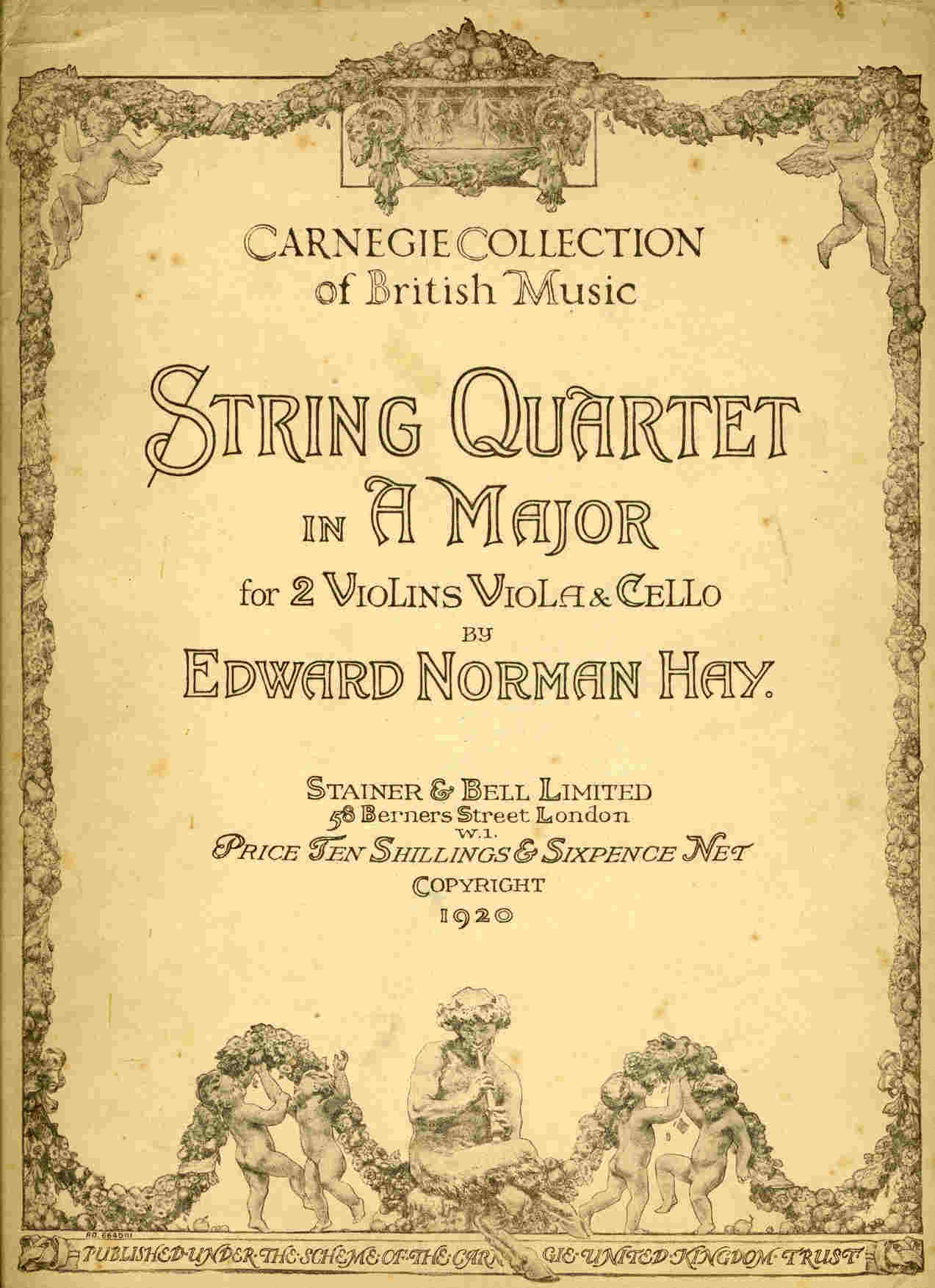
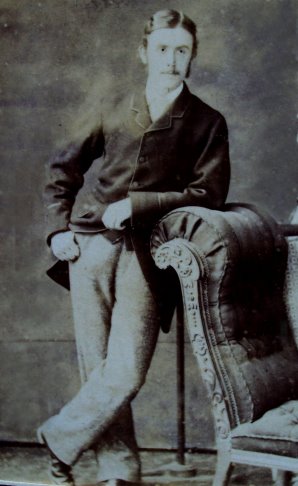
The soprano lead (Elsie McQuilkin, daughter of a grocer on the look out for a Government appointment) was taken by a local girl Miss Hessie Haughey who Hay married the following year.
MacLaughlin wrote the words and lyrics for The Lady Voter's Dilemma.
He contributed An Irish Serenade or Oh, Molly, I can’t say that you’re honest to Sam Henry’s Songs of the People. MacLaughlin lived at Breezemount, Coleraine.
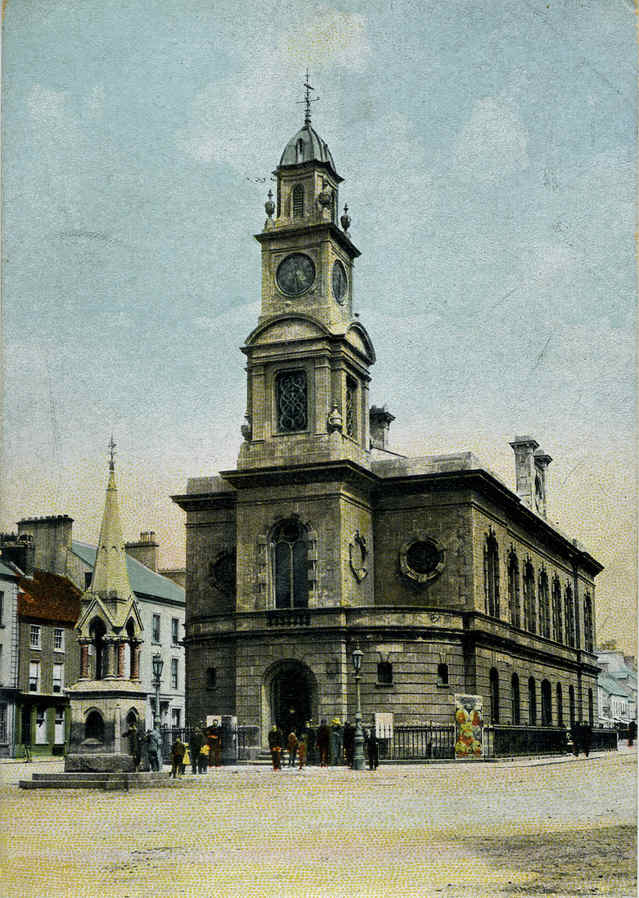
Into the 1920s
The Overture to Hay's The Gilly of Christ was played through at a Royal College of Music Patron's Fund open rehearsal on 20 November 1920 - an opportunity for young composers to hear their music performed by a professional orchestra. Also on the programme was York Bowen's Symphonic Fantasia and music by W.C. McNaught and G.H. Sullivan.
Back in 1912, Godfrey Brown (1874-1955) had succeeded Dr Francis Koeller as conductor of the Belfast Philharmonic Society, a large choral society with an orchestra of amateurs, semi-professionals and professionals. For many years Brown remained a close friend and encouraging supporter of Hay. In 1921 the Society gave the first performance of Hay's Dunluce, described by a Musical Times correspondent as a symphonic tone-poem containing “many exquisite and original melodies developed with great skill”.
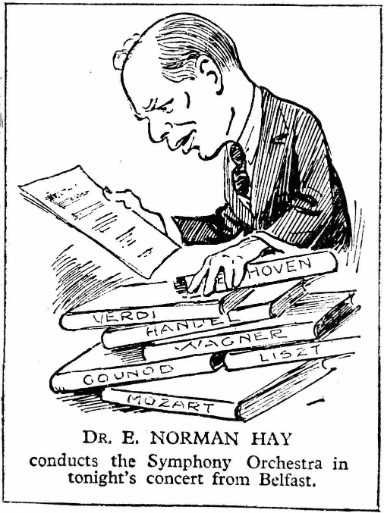
"To Wonder" and the BBC
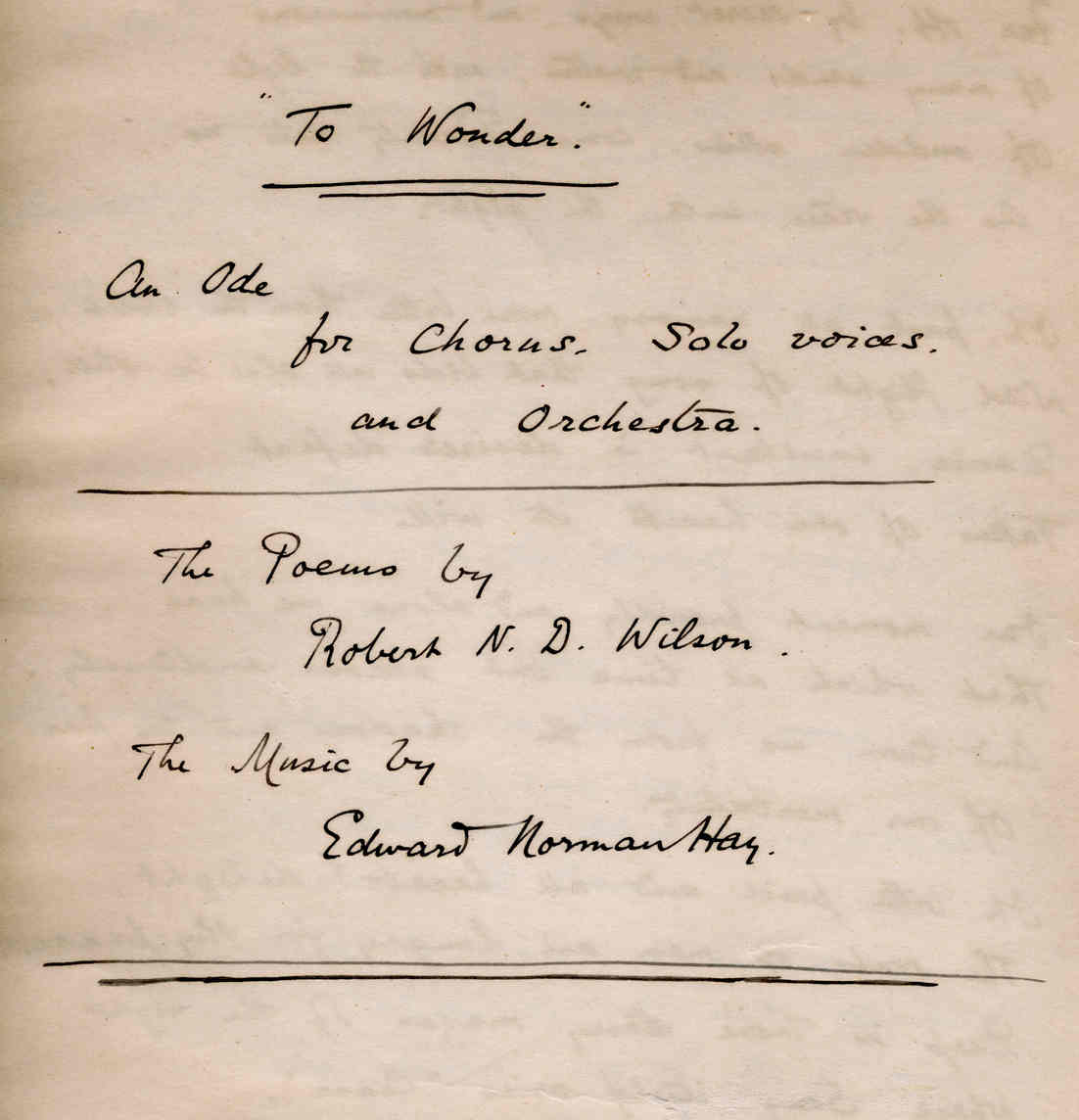
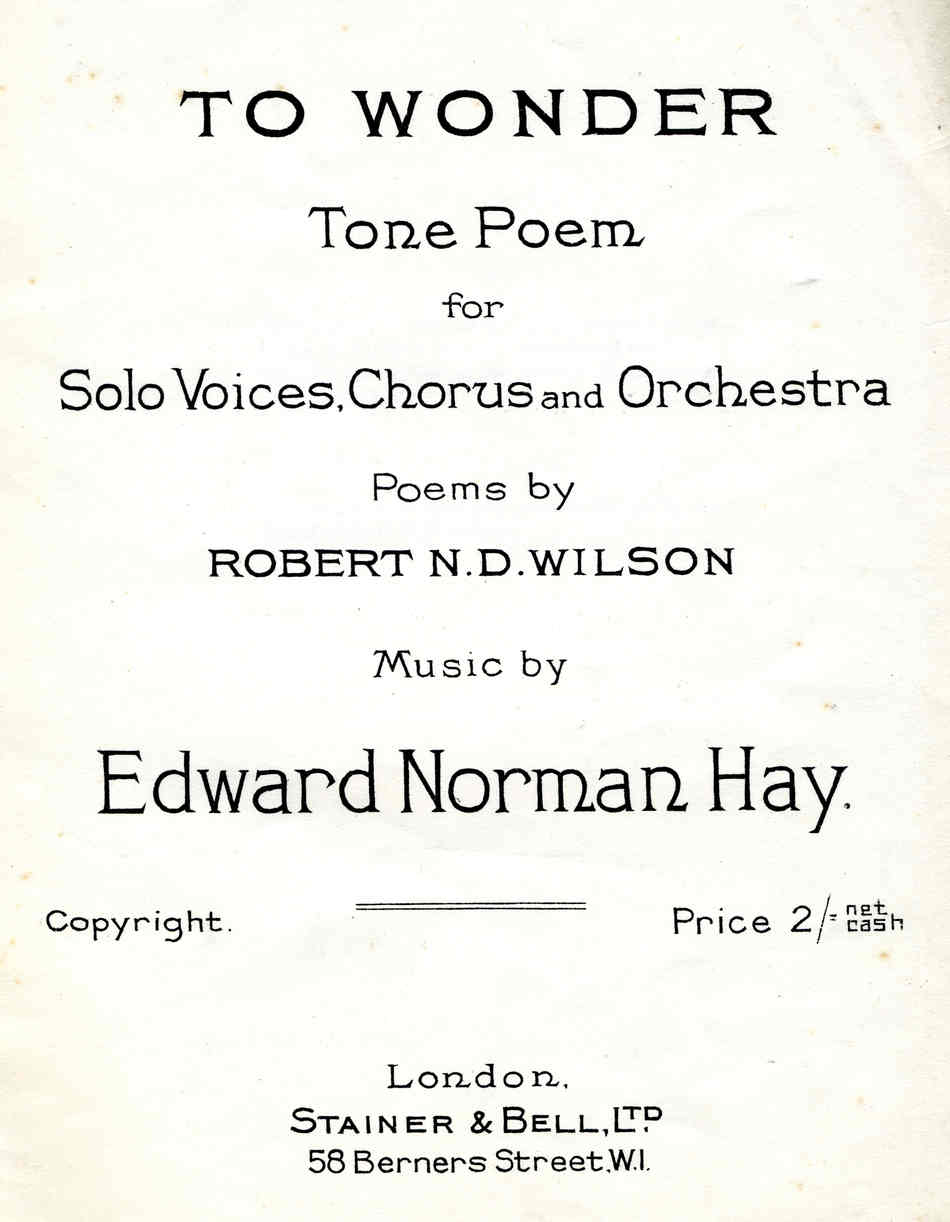
LH pic: Stainer and Bell's title page.
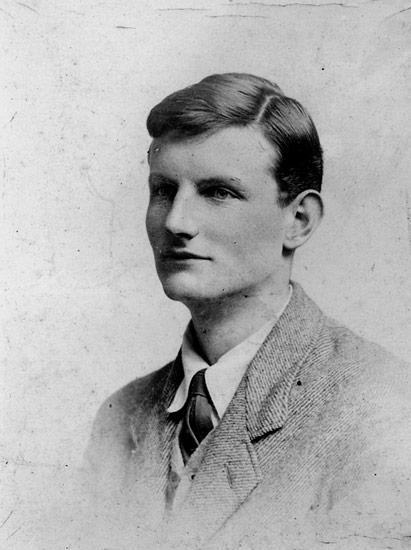
Rathcol
The ULT's first popular success was Suzanne and the Sovereigns (1907), described as a "fantastic burlesque". Sam Hanna Bell has written that, for the 1909 revival, the incidental music "was composed by Carl Hardebeck, A.G. Potter [Arthur George Potter, father of composer A.J. Potter - both Hardebeck and Potter were blind] and W.B. Reynolds. The opening music Overture 1690 is credited to Reynolds. Based on tunes such as The Boyne Water and The Boys of Wexford, it seems to have been as witty and entertaining as the extravaganza."
Reynolds was the first composer to send James Joyce some musical settings of the writer's Chamber Music. Hay also admired Reynolds' compositions, but so far none of those works has been traced (a Joyce setting, The Kiss, a part-song for female voices. advertised on Google Books, was presumably sold). There is evidence that Reynolds was involved in some way in 1913 with an opera scenario for Diarmuid and Grania, linking into the Moore - Yeats - Elgar story.
In the 1911 census, W.B. Reynolds was living at 32 Victoria Gardens, Belfast. He described himself as a 37 year old "musical journalist", Presbyterian, born in Co. Antrim, married 2½ years to Clare Gwendolyn Reynolds (née Breakey), aged 28, Church of Ireland, born in Co. Donegal. They had one son, William George Reynolds, aged 19 months, who had been born in Belfast. William Conor painted a small portrait of Reynolds, though I've lost track of its whereabouts.
H. Simonis, writing of the Belfast Evening Telegraph in The Street of Ink (New York 1917), stated that "The musical critic, W. B. Reynolds (Rathcol), has much more than a local reputation".

|
Hay previews 1937-38 BBC orchestral concerts in Belfast.pdf Size : 224.21 Kb Type : pdf |
The 1930s and the "Ulster Airs"
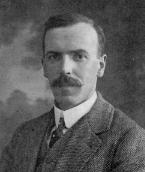
The PDF on the right is a 1946 feature about Godfrey Brown published in the Belfast Telegraph.

|
Godfrey Brown.pdf Size : 287.241 Kb Type : pdf |
Paean was performed in Belfast on 30 May 1931.
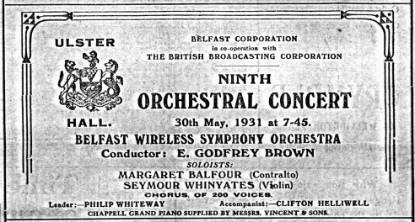
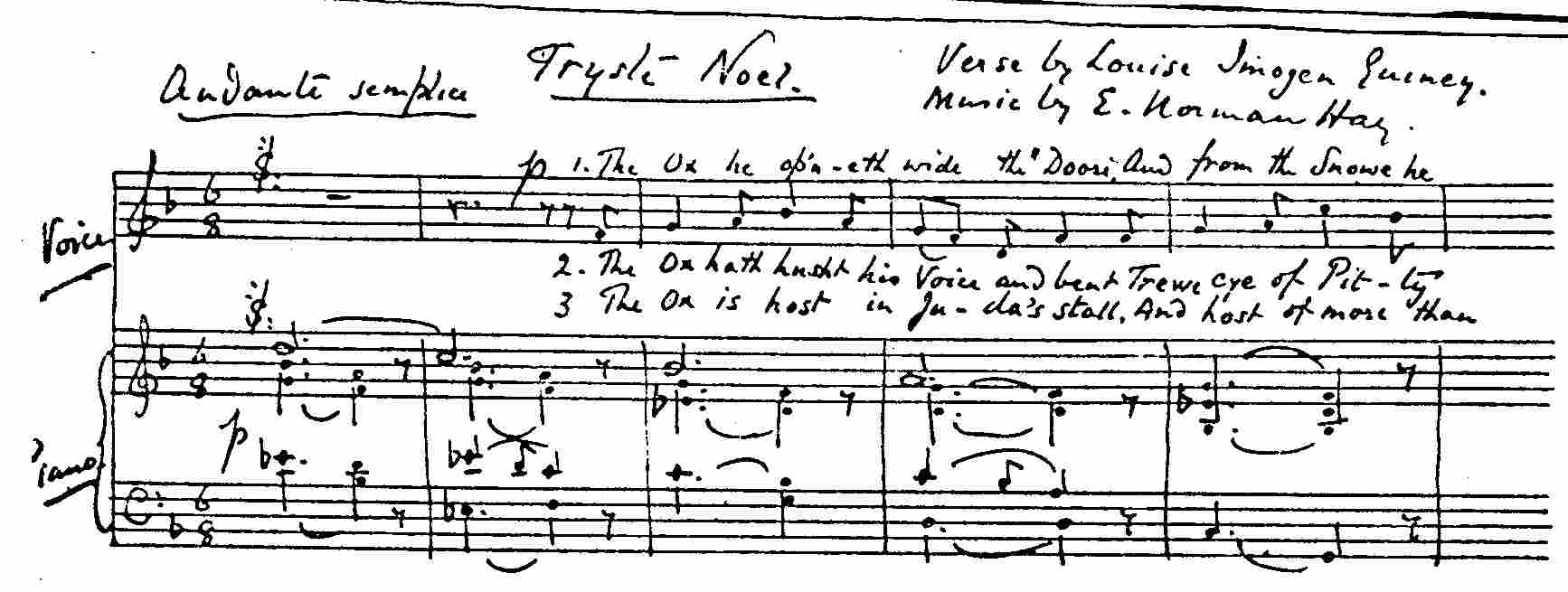
"It is our hope that we can preserve permanently these airs in a setting suitable for performances by either string or full orchestra and yet retain the essential melody, so that it will still be appreciated and understood by the country folk to whom it is familiar in its simple form."
RH pic: Norman Hay in the BBC studio in Belfast.
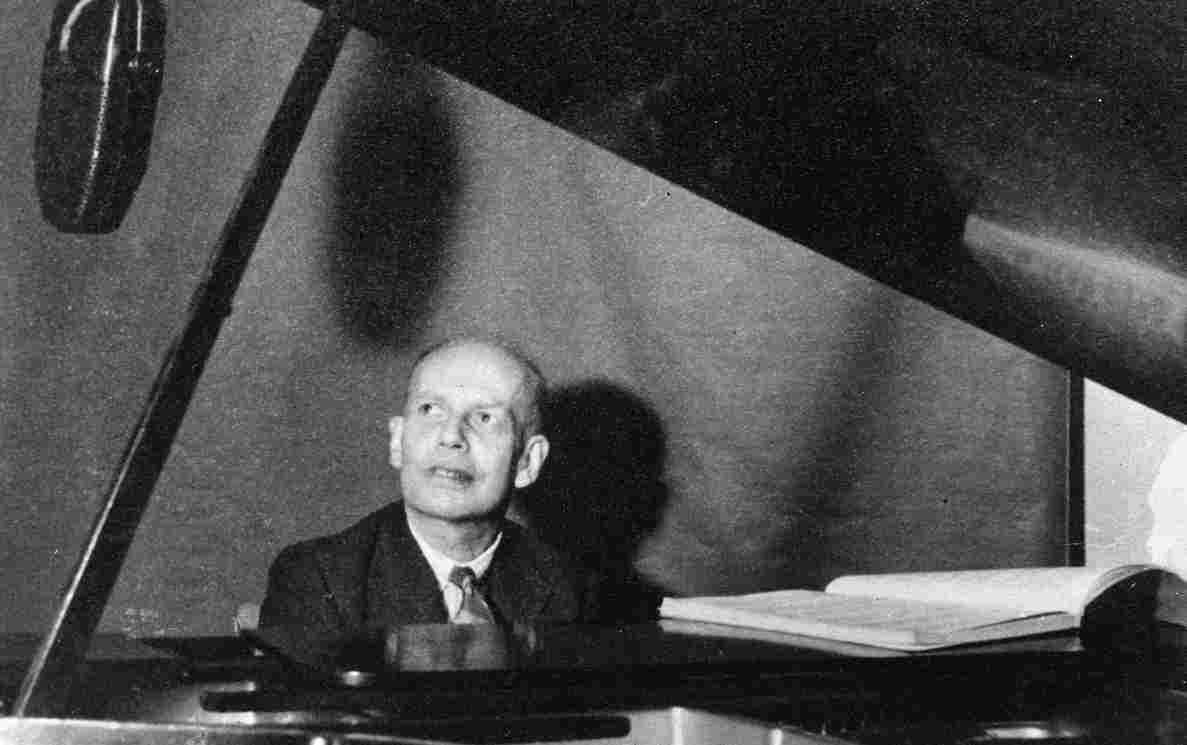
Summing up
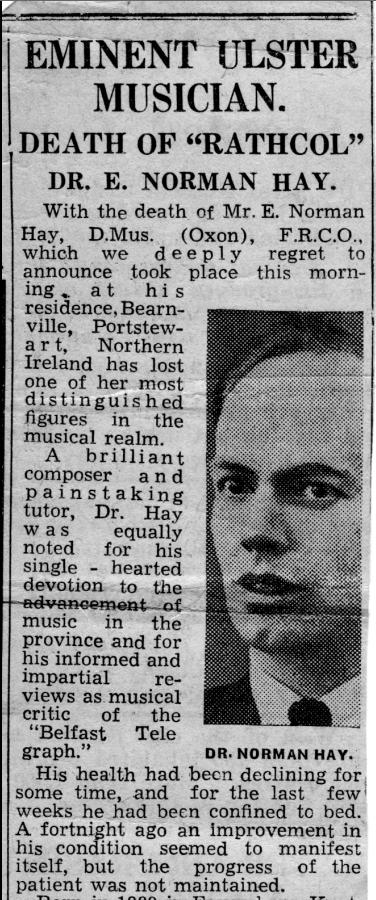
Norman Hay's compositions
Hay Wohin.mp3
Hay Friedenshoffnung.mp3
Overture Orchestration: 223(1.2.bcl)2 - 4231 - T - strings
(in the other movements harp and organ are added and the second oboe is required to double on cor anglais)
Hay Fragment 10 12 1916.mp3
Claudy, Sally Kelly (mid-18th century), Cobbett Prize 1917, (3rd place – 2nd was Howells – prize awarded for a folk-song phantasy for string quartet), score missing, 1917.
Hay String Quartet First movement.mp3
Hay String Quartet Second movement.mp3
Hay String Quartet Third movement.mp3
Hay String Quartet Fourth movement.mp3
N.B. Vocal parts and full score missing, but orchestral parts survive.
Overture Orchestration: 1011 - cornet.horn T+2 - strings
Orchestration: 2(picc)2(ca)22 - 4331 - T+3 - hp - glock - strings
The programme note from that concert is given below in full (my editorial insertion of "accompaniment" replaces the word "introduction").
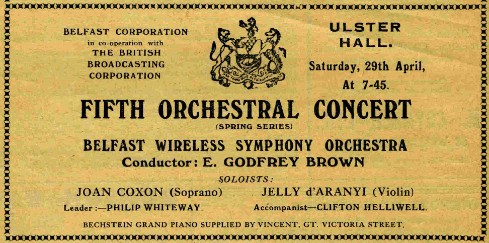
This work was composed at the request of the Committee of the Belfast Philharmonic Society, and received its first performance on February 21st, 1921. At a later date it received a hearing in London at the Queen’s Hall, under the composer’s direction.
Dunluce is an attempt to comprise, within the limits of the symphonic poem, the various movements of the orthodox symphony. The work opens with a meditative introduction chiefly for cor anglais with harp [accompaniment]. Then follows an Allegro ben moderato, representing the Exposition of “First Movement” form. This is succeeded by a reel and jig section which stands for the Scherzo. The slow movement follows, largely for solo cello, after which there is a recapitulation of the material of the Allegro, and the work concludes with a return to the meditative opening.
Dunluce is not built upon any definite programme, save that the Scherzo endeavours to suggest the old-time revelry of Celt and Gael in the Castle.
settings of W.B. Yeats, dated September-December 1921.
Orchestration: 223[1.2.bcl]2 - 4231 - T+3 - hp - strings

|
Prog note The Wind among the Reeds.pdf Size : 341.633 Kb Type : pdf |
Hay O curlew, cry no more.mp3
Hay Behold what manner of love.mp3
No score available at present.
publ. Stainer & Bell, 1924.
Orchestration: 2222 - 2231 - T+2 - pf - cel - org - strings
Prelude - orchestration: 1121 - 2110 - T - hp - strings
Hay Prelude Land of Heart's Desir.mp3
Hay Thou O God hast taught me.mp3
Orchestration: 2(picc)2(ca)22 - 3220 - T+2 - hp - cel - strings
ii The Book of Kells, dated 26 December 1929
Orchestration: 22(ca)22 - 3230 - T - hp - strings
iii The Glensfolk make merry, dated 30 December 1929
Orchestration: 2(picc)222 - 3230 - T+2 - hp - cel - strings
iv The Third Tree of Garvagh, dated 17 January 1932
Orchestration: 2(2picc)222 - 4231 - T+2 - hp - strings
These are the opening bars of i, iii and iv, with an excerpt from ii:
Hay Irish Sketches i.mp3
Hay Irish Sketches ii.mp3
Hay Irish Sketches iii.mp3
Hay Irish Sketches iv.mp3
Orchestration: 2222 - 3231 - T+2 - hp - org - strings
dedicated to the members of the Belfast Wireless Symphony Orchestra, 1931-1933
Orchestration: 2(picc)2(ca)22 - 4231 - T+3 - hp - cel - strings
RH pic: a cutting from the Radio Times (with deteriorating glue!)
Hay My song shall be of mercy.mp3
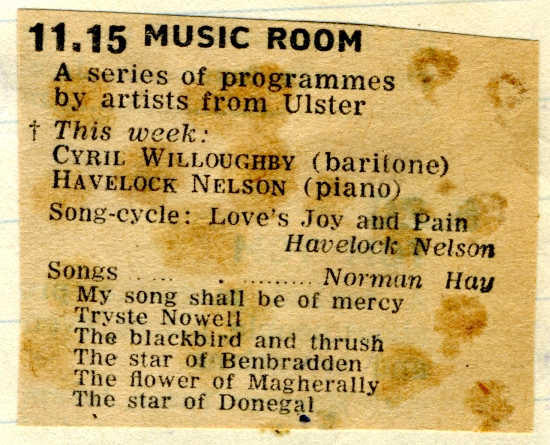
Opening bars:
Hay Blackbird and Thrush.mp3
Opening bars:
Hay Star of Ben Braden.mp3
Opening bars:
Hay Flower of Magherally.mp3
Opening bars:
Hay Star of Donegal.mp3
Opening bars:
Hay Tryste Noel.mp3
1. March Jig on Garryowen and Lilliburlero (Protestant Boys)
2. Inniskilling Dragoon (or Johnny Doyle)
10. The yell heifer and Sporting Kate (reels)
Hay The yell heifer and Sporting Kate.mp3
11. Lament for Hugh Reynolds (strings only)
The copy is dated '9.39'.
Hay Lament for Hugh Reynolds.mp3
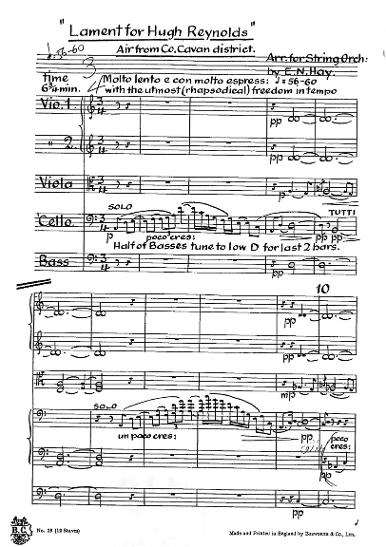
14. Young Edward
15. Bonnie Portmore
24. The mantle so green
32. The point maid
33. The woods of Mountsandel
36. Squire Agnew’s hunt
44. My charming Coleraine lass
45. The rich shipowner’s daughter
61. The Derry boys
64. The banks of Claudy
78. The sweet Bann water
79. Flanagan’s jig and The Connaught man
81. Farewell to Londonderry
82. The Ballinderry marriage
86. Kellswaterside
88. Kitty my love, will you marry me
93. The Lady Leroy
94. Where the moor cocks crow
99. The cuckoo
104. My charming Kate O’Neill
109. Hey lad, come marry me
Excerpt:
Hay The breeze from Scotland.mp3
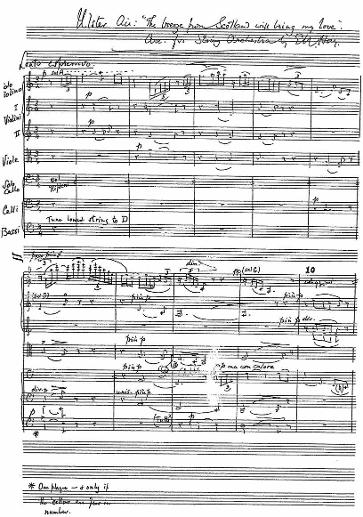
112. The maid of Ballyhaunis
114. Art McBride
119. Dirge of Ossian
120. Miss Peel at the Ball
124. The mountain high
125. To all true lovers
129. Death of the whiskey
130. They say my love is dead
134. The lass from Turfahun
139. The buttermilk boy
140. The green bushes
144. The jacket blue
145. The ripest of apples
149. Whiskey is my name
154. The rakes of Coleraine (march-reel)